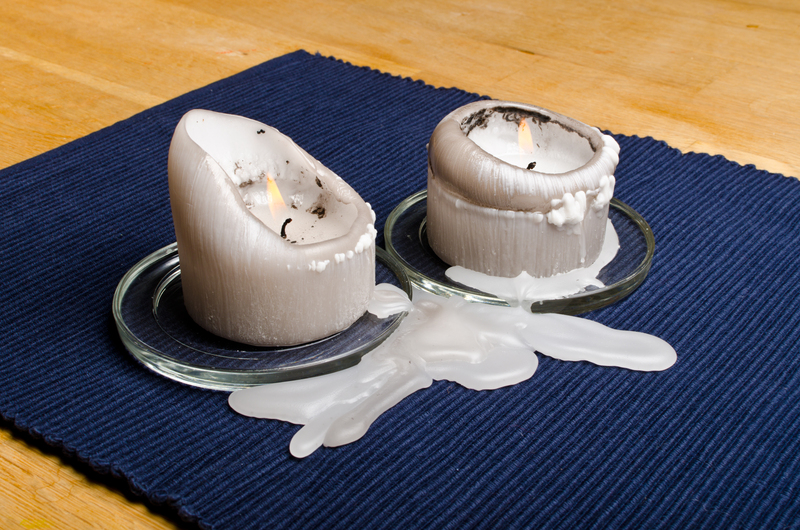Professional Strategies for Deep Cleaning Your Car
Posted on 30/05/2025
Professional Strategies for Deep Cleaning Your Car
Deep cleaning your car is more than just a simple wash and vacuum; it's a thorough process that transforms your vehicle both inside and out. Whether you're prepping your car for resale, want to maintain its value, or simply enjoy driving a clean, fresh-smelling automobile, adopting professional strategies for car deep cleaning can make a remarkable difference. In this guide, we'll walk you through comprehensive car cleaning tips, step-by-step instructions, and essential tools for car detailing, ensuring your vehicle looks and feels as good as new.
Why Deep Cleaning Your Car Matters
The benefits of a meticulously cleaned vehicle go far beyond aesthetics. Regular deep cleaning helps:
- Preserve resale value by maintaining interior and exterior surfaces
- Protect paintwork from contaminants like road salt, sap, and pollutants
- Eliminate allergens, dust, and pet hair for a healthier in-car environment
- Enhance driving comfort and overall satisfaction
- Prevent long-term damage such as stains, corrosion, and mildew buildup
Adopting professional car cleaning strategies can be the key to prolonging your vehicle's life and maintaining that showroom shine.

Must-Have Supplies for Deep Car Cleaning
Before starting, assemble the following supplies commonly used by professionals:
- Two buckets (one for soapy water, one for rinsing)
- pH-neutral car shampoo
- Microfiber towels and soft mitts
- All-purpose cleaner for interior surfaces
- Detailing brushes for vents, buttons, and tight spaces
- Vacuum cleaner with hoses and crevice attachments
- Carpet and upholstery cleaner
- Leather conditioner (if applicable)
- Glass cleaner (preferably ammonia-free)
- Clay bar kit for removing stubborn contaminants
- High-quality wax or sealant
- Wheel cleaner and tire brush
Tip: Professional detailers recommend organizing your products and tools before starting to streamline the process.
Step-by-Step Professional Car Deep Cleaning Process
1. Preparatory Steps: Decluttering and Pre-vacuuming
Begin by removing all personal belongings, trash, car mats, and detachable seat covers from the interior. Having a clear space allows for more effective cleaning and ensures no spot gets overlooked.
- Inspector's tip: Check under seats, between cushions, and in storage compartments for forgotten items and stubborn crumbs.
2. Interior Deep Cleaning Strategy
A. Vacuuming Like a Pro
Use a high-powered vacuum with a variety of attachments. Pay special attention to the following areas:
- Cup holders
- Air vents
- Under the seats
- Between seat crevices
- Floormats and carpeted surfaces
Repeat this process twice: once as a rough vacuum and again after cleaning, to pick up any loosened debris.
B. Carpet and Upholstery Cleaning
Use a carpet cleaner or professional upholstery shampoo. For fabric seats and carpets:
- Apply the cleaning product evenly across the fabric.
- Gently agitate with a soft brush to lift embedded dirt.
- Allow the cleaner to penetrate for a few minutes.
- Blot or extract with a wet/dry vacuum.
- Allow drying with car doors open for ventilation.
To neutralize odors, sprinkle baking soda on carpets and vacuum after 15-30 minutes.
For stubborn stains: Use a dedicated stain remover or spot cleaner as soon as possible for the best results.
C. Leather Seat Care
If your vehicle has leather interiors, use a pH-balanced leather cleaner and conditioner:
- Clean gently with a soft cloth or brush
- Avoid oversaturating the leather, which can lead to cracks
- Apply conditioner for suppleness and protection
Never use harsh chemicals, which can strip the leather's natural oils.
D. Cleaning Plastic, Vinyl, and Trim Surfaces
Wipe down dashboards, door panels, and console areas with an all-purpose cleaner and microfiber towel. For textured trims, use a soft-bristle detailing brush to dislodge dust and grime.
- Don't forget: steering wheels, gear shifters, and window switches are high-contact zones that require disinfection.
Finish with a UV-protectant spray to prevent fading and cracking from sun exposure.
E. Glass and Mirror Cleaning
Crystal-clear glass enhances visibility and the overall appearance of your car. Use an ammonia-free automotive glass cleaner with a streak-free microfiber cloth. Clean both interior and exterior surfaces, working in overlapping motions.
For hard-to-reach corners, a foam brush or cotton swab can ensure a spotless finish.
F. Air Vent, Crevice, and Button Detailing
Professional detailers swear by small, soft detailing brushes and compressed air for cleaning vents and tight spaces. Work gently to avoid damaging sensitive electronics.
For a fresh-smelling cabin, replace the cabin air filter and use mild deodorizing sprays or neutralizers.
3. Exterior Deep Car Cleaning Techniques
A. Wheel and Tire Cleaning First
Always start with the wheels and tires--they're typically dirtiest. Use a dedicated wheel cleaner and a stiff-bristled brush to remove brake dust and road grime. Scrub tire sidewalls as well, then rinse thoroughly.
B. Pre-Wash and Foam Soak
The best way to minimize micro-scratching is a pre-wash foam soak. Apply with a foam cannon or sprayer, letting it dwell 5-10 minutes to loosen dirt. Rinse with high-pressure water.
- Never wipe a dry dirty car--this can grind dirt into your paint and cause scratches.
C. Two-Bucket Hand Washing
The classic two-bucket method is a staple of professional auto detailing. One bucket is for suds, the other for rinsing your mitt. Use a pH-neutral shampoo and plush microfiber wash mitts:
- Wash top-to-bottom; roof, windows, then body panels
- Rinse the mitt frequently to avoid reapplying grit
- Rinse the entire car thoroughly before drying
D. Decontamination: Clay Bar Treatment
A clay bar removes stubborn contaminants embedded in your paint (like tar, sap, and rail dust). After washing, lubricate a section and gently rub the clay bar over the paintwork until it feels smooth.
Follow this step with another rinse and dry using a soft microfiber towel.
E. Polishing and Swirl Removal
If you want that showroom finish, polish your car using either a manual applicator pad or a dual-action polisher. This step removes light scratches, oxidation, and swirls, restoring the paint's gloss.
- Always work in the shade and on a cool surface to avoid product drying too quickly.
F. Waxing and Paint Protection
After polishing, seal the paint with a quality wax or synthetic paint sealant. Work in small sections, allowing the product to haze, then buff with a clean microfiber towel for a brilliant, long-lasting shine.
G. Detailing Finishing Touches
- Clean exterior glass (windows, mirrors, lights)
- Dress and condition all rubber trims and tires for a deep, satin-black look
- Check door jambs and fuel filler areas for lingering dirt
- Clean windshield wipers, emblems, and grilles
The difference is in the details--these small touches set a professional result apart from a standard driveway wash.
Pro Tips for Maintaining a Spotless Vehicle
- Keep a trash bag and microfiber cloths in your car for quick cleanups
- Vacuum interiors at least monthly to prevent buildup
- Apply a ceramic coating every 6-12 months for superior paint protection
- Protect seats with cloth or leather conditioners every quart
- Store cleaning products in a tote to streamline regular touch-ups
- Consider using all-weather mats for easy maintenance
Common Mistakes to Avoid When Deep Cleaning
- Skipping wheel cleaning last: Dirty water splashes can re-soil clean panels if left for last.
- Using household cleaners: Many bathroom and kitchen products can damage delicate automotive finishes.
- Washing in direct sunlight: This leads to water spots and faster drying, making products harder to buff.
- Ignoring small crevices: Missed dirt attracts mold or causes premature wear in controls and surfaces.
- Using abrasive towels: Only use soft, clean microfiber towels to avoid scratches and residue.
When to Seek Professional Detailing Services
Certain deep cleaning challenges may require professional intervention:
- Severe pet hair, mold, or smoke odors that resist home cleaning efforts
- Paint defects (deep scratches, etching, oxidation) needing advanced tools and products
- Convertible top care or specialty fabric/carbon fiber interiors
- Excessive salt or chemical stains from harsh climates
Professional auto detailers have specialized equipment (steam cleaners, ozone generators, extractors) for these tough cases, restoring your vehicle with expert techniques.

Eco-Friendly Deep Cleaning Solutions
The best deep cleaning strategies also consider environmental impact:
- Choose biodegradable, pH-neutral cleaners
- Limit excessive water runoff with low-water washing systems
- Use reusable microfiber towels instead of paper wipes
- Safely dispose of contaminated rinse water
Eco-friendly car cleaning protects the planet and your vehicle's surfaces.
Conclusion: Make Deep Car Cleaning a Habit
Adopting professional-grade car cleaning strategies extends your vehicle's life, preserves its value, and enhances driving enjoyment. By following the steps outlined in this comprehensive guide--from thorough interior detailing to expert exterior care--you can achieve stunning results rivaling those of professional detailers. Create a regular cleaning schedule, invest in quality products, and pay attention to the little things to keep your car spotless and refreshed year-round.
Ready to transform your car? Grab your cleaning kit and experience the rewards of professional deep cleaning for your vehicle today!




